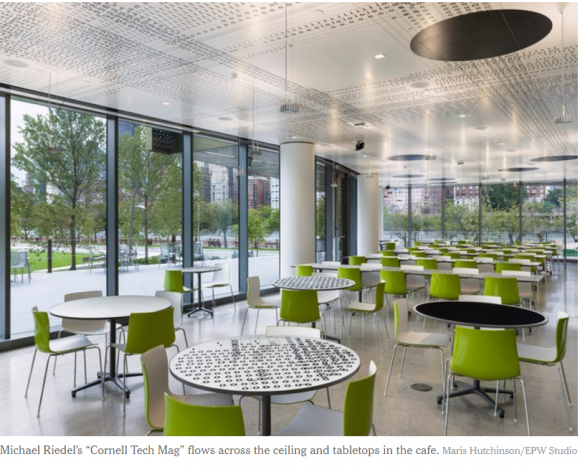Dear Commons Community,
When Cornell Tech on Roosevelt Island in New York City opened its doors for the first time this semester, faculty, students and visitors were treated to various works of art designed to stir imagination and innovation. The New York Times has an article today featuring the artwork at Cornell Tech carefully commissioned to help students and faculty to immerse and to think. Here is an excerpt from the article.
“Since the first crop of engineering graduate students arrived last month at the brand-new Cornell Tech campus on Roosevelt Island, many have been busy decoding the diagrams in Matthew Ritchie’s dynamic mural rising up four stories in the atrium of the Emma and Georgina Bloomberg Center, the main academic building.
This is not lobby decoration tacked on as an afterthought. From the early design stages, Thom Mayne, the founder of Morphosis Architects, and his team integrated the mural and four other immersive installations in the cafe and unexpected “discovery rooms” throughout the new building: an art program engineered to provoke creative thinking. “The entire building is designed to spur imagination and innovation and sometimes unintentional interactions,” said Patricia Harris, chief executive of Bloomberg Philanthropies.
More than 1 percent of the building’s overall budget of $130 million (funded by Bloomberg Philanthropies and the city) was invested in new artworks by Mr. Ritchie, Michael Riedel, Matthew Day Jackson and Alison Elizabeth Taylor, as well as in the restoration and relocation of a historic 50-foot-long mural by Ilya Bolotowsky. This canvas had hung in the Coler-Goldwater Memorial Hospital razed to make way for the Cornell Tech campus.
Cornell University and Technion — Israel Institute of Technology formed the partnership of Cornell Tech in 2011 and won New York City’s competition to develop an applied-sciences campus. As part of the deal, in which the city provided funding and land, Cornell Tech agreed to preserve three large-scale paintings in the derelict W.P.A.-era hospital. An Albert Swinden mural has been installed in the new Bridge building adjacent to the Bloomberg Center, and a Joseph Rugolo work will find a home in the next construction phase.
The Bolotowsky canvas — an abstract composition of geometric shapes in a soothing palette of blues, pinks and beiges — had wrapped around a circular room in the hospital and required Mr. Mayne to accommodate a similar space in his floor plan. “This helped us think about how we could have other hidden rooms as an element of surprise,” Ms. Harris explained.
These enigmatic spaces include Mr. Jackson’s “Ordinary Objects of Extraordinary Beauty,” a continuation of his series called “Study Collections.” The small trapezoidal meeting room is lined with shelves displaying natural and found objects — like bones, ceramics and branches — as specimens. “The things these students will dream up are at the cutting edge of the application of new science,” Mr. Jackson said. “I wanted to present a room where they could sit and think about the material resources available on earth and what they’ll do with them.”
The students will be unplugged while they’re contemplating. Andrew Winters, senior director for capital projects at Cornell Tech, said there are no outlets or wiring for electronic devices in the room, to encourage people to sit and talk. Part of the art program is to help students, faculty and researchers “get away from what they’re doing day to day,” Mr. Winters said. “Facebook and Pixar offices have secret rooms for people to go do yoga or sleep. We tried to elevate that a little bit.”
The architects at Cornell Tech have thought deeply about how to use art to stir minds!
BRAVO!
Tony






